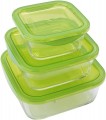Min. capacity
The volume of the smallest container included in the set (see "Type"). In fact, there are quite a few situations when you need to pack a small amount of food, and a large container is not required. On the other hand, if the set is planned to be used regularly for numerous products, then perhaps the smallest tray should be quite large. See "Maximum Volume" for details on specific volumes.
Max. capacity
The largest volume of the container supplied with the kit. For sets (see "Type") in this case, the capacity of the largest container is indicated, for all other types — the actual nominal volume. Useful volume may be somewhat less, because. not all containers and not in all cases can be stuffed “under the very lid”. However, this difference is small, and this figure characterizes the capacity of the product well.
Estimating the amount of food that can fit inside, we can proceed from the fact that 1 liter of volume approximately corresponds to 1 – 1.2 kg of soup or a tightly packed product (for example, mashed potatoes) or 700 – 800 g of food, divided into pieces and not packed very tightly (for example, fried potatoes or salad). A large container takes up more space, and too little food can hang around inside, which usually does not contribute to safety. Therefore, too large a volume is just as undesirable as too small.
Shape
General shape of the container(s). Please note that extensive sets (see “Type”) may include containers of different shapes; for such cases, the option that most containers correspond to is usually indicated; the remaining options are given in the notes.
The most popular shapes are classic geometric shapes -
circle,
oval,
square,
rectangle. At the same time, containers that differ slightly in the length of the sides can also be classified as squares - if this difference is not noticeable to the eye. Non-standard containers are also produced, often they have an original design - for example, a semicircle with an orange slice coloring.
The shape determines the appearance, overall ease of placement of the container and ease of cleaning. So, for example, round containers have a minimum of corners, and some are generally made in the shape of a hemisphere - which makes them easier to clean compared to square and rectangular ones. On the other hand, square and rectangular containers are most useful when storing in tight spaces, such as a busy refrigerator - they can be stacked as tightly as possible, side by side, whereas round containers will inevitably have gaps between them.
Min. temperature
The minimum temperature that a container can safely tolerate. Almost all modern food containers normally tolerate positive temperatures. So you should pay attention to this parameter only if the container is planned to be used for
deep freezing, or used in harsh winter conditions. However, the minimum temperature in domestic freezers is rarely below -24 °C, while for food containers it is -40 °C as a standard. On the other hand, it is worth noting that many models have no mention of a minimum temperature at all; it is necessary to use such products in the cold, taking into account the materials from which they are made (see above), and if possible, refrain from doing so altogether.
Max. temperature
The maximum temperature that the container can safely endure. Note that overheating the container can lead not only to its damage, but, in some cases, also to the release of harmful substances. Therefore, in no case should the claimed temperature be exceeded — even if the container remains intact, this does not mean that everything is fine.
The most delicate modern food containers have a maximum limit of 35 – 40 °C — this allows them to be used only for unheated food. Values of 70 °C are already found even among models compatible with microwave ovens, although for maximum guarantee it is desirable that the allowable temperature be at least 100 °C. And the most heat-resistant products (usually heat-resistant glass) can withstand temperatures up to 300 – 400 °C and can even be used for baking in the oven (although this heat resistance usually does not apply to lids, and they must be removed).

